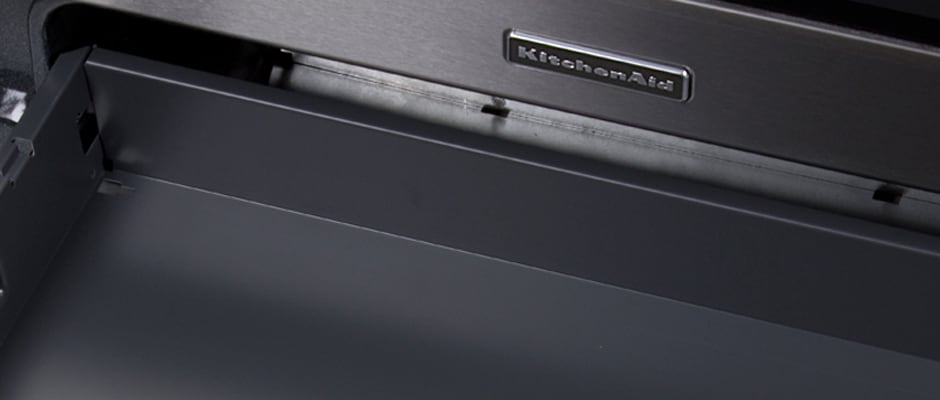Pros
Cons
Introduction
While we can't objectively tell you whether the stainless steel KGRS308BSS will meet your needs, we can tell you that it is a fantastic performer, ready for whatever culinary task you throw at it, onto it, or into it. The exceptional gas rangetop performed quite well, acing our boiling test, and down below, the oven kept temperatures close to the target for even cooking.
With features including a convection mode, a griddle, and an "AquaLift" self-cleaning method, it's hard to go wrong.
Design & Usability
{{section_header}}{{section.name}}{{/section_header}}
Stainless is the eye-candy of today's kitchen, and this KitchenAid has plenty of it.
The {{product.name}} is a traditional single oven gas range with a fifth burner added in the center. The stainless steel finish approximately follows the same design language of some of the other {{product.brand.name}} ranges we've seen. This good-looking oven hosts a keep-warm drawer below, and sharp, industrial continuous grates along the rangetop. But don't take our word for it—head over to the photo gallery and run your own aesthetics test.
The large 5.8 cubic foot oven cavity is certainly large enough to accommodate the Thanksgiving turkey and whatever else you throw into it. Three, arrangeable racks divide the oven: one rack is max capacity, one is split, and one is a "SatinGlide" roll-out extension rack. Of course, a large convection fan sits at the back, circulating the hot air to cook items more quickly and efficiently.
The cleaning method is different from the normal pyrolitic way. Instead of simply heating up for an extended period, this oven uses a water-based system called "AquaLeft" that cleans at lower temperatures. This method is much quicker, something that messy users will definitely appreciate. Under an hour at 250°F is certainly more desirable than hours at 550°F.
{{photo_gallery "Vanity", "Front", "Rangetop Controls Photo", "Oven Controls Photo", "Burners 1 Photo", "Burners 2 Photo", "Burners Cleaning Photo", "Upper Oven Photo", "Upper Oven Detail Photo", "Oven Detail Photo", "Lower Oven Detail Photo", "Lower Oven Photo", "Drawer Photo", "Broiler Photo",}}
Rangetop
{{section_header}}{{section.name}}{{/section_header}}
We found excellent boiling and gas precision from this spirited range.
The gas rangetop sprinted to boil in our tests, although it didn't demonstrate a very wide range of temperatures for searing and simmering. This is the classic tradeoff with gas vs. electric. Though the temperature range proved narrow, the {{product.model}} has the superior precision and responsiveness that make restaurant chefs choose gas almost every time.
In addition to the four fantastic gas burners on the rangetop, a fifth 8,000 BTU burner lies in the center for more options. {{product.brand.name}} conveniently provides a griddle plate for the center burner when you buy a {{product.model}}, a nice change from all the "sold separately" speak.
Oven Broiler & Convection
{{section_header}}{{section.name}}{{/section_header}}
A baker couldn't ask for more.
This model's ability to maintain the proper temperature impressed us very much. Moreover, this oven treats user input as an order, not a suggestion, so temperatures are delightfully consistent. Even temperatures mean even cooking, so this is something that bakers should definitely think about when considering this appliance.
The oven didn't tarry to 350°F, taking just under 11 minutes. The convection fan didn't quite perform as spectacularly as the conventional mode did, but with the bar set so high, it was a long shot anyway. And for those who care less about the quality of the service and more about the speed: the oven didn't tarry to 350°F, taking just under 11 minutes to heat the 5.8 cubic foot cavity.
The broiler, the frequent underbelly of residential ranges, played that role again in the KitchenAid KGRS308BSS. Floundering weakly with the potency of an O'Douls non-alcoholic beer, it failed our tests.
Conclusion
This is a spectacular range.
For around $1,650 (MSRP $1,799), the {{product.name}} is a fairly expensive oven, so we expected performance as high as the stack of money it takes to buy it. Through vigorous testing, this model performed very well compared to the field, and lived up to its price tag, as well.
The rangetop boiling abilities were phenomenal, with all three non-simmer burners able to boil six cups of water in under 10 minutes, and one of them in just five minutes. With the extra center burner and the griddle feature, the rangetop balances high performance with features—a mix to satisfy any chef. Often we see electric outperform gas, but not this time; these top-tier results, combined with a gas range's ease-of-use, constitute a winning package. The only disadvantage we saw was the rangetop's marginal simmering ability, so small quantities of liquid may require close attention.
While the oven didn't heat up that quickly, taking more than 10 minutes to reach 350°F, it performed splendidly once it got there, showing great accuracy as well as minimal temperature fluctuation. These two things ensure that food isn't overcooked or burnt on the outside and raw on the inside. Bakers and roasters will appreciate this very much. Unfortunately, the broiler didn't function well and timed out on our test, so it might be best to grill elsewhere.
The bottom line here is whether you need all these features and performance perks badly enough to foot the bill for this luxury item. If you need it and you can afford it, this would be a phenomenal machine to own.
Science Introduction
{{section_header}}{{section.name}}{{/section_header}}
Sure you've read what we think about the KitchenAid KGRS308BSS, but since you're here you probably want to know how the sausage is made. This is the view from behind our Ozian curtain.
Oven Performance
{{section_header}}{{section.name}}{{/section_header}}
The oven is accurate and smooth, like Brian Williams.
The low end of the temperature range is exactly where we like it to be, averaging around 170°F for the keep-warm setting—cool enough to refrain from further cooking, but hot enough to prevent chicken saltimbocca from becoming chicken salmonella. The 350°F temperature was also accurate, but the maximum setting was a bit under the industry standard of 550°F, at 500°F, and not particularly accurate, either. Fortunately, that may not be an issue for chefs, who often simply need a "hot" temperature.
Here is where the {{product.brand.name}} really shines: During the keep warm setting, it strayed no more than 3°F below 170°F, and no more than 11°F above. Whoa. At 350°F, it only went 15°F above and 11°F below, and at the maximum temperature, we still liked what we saw. These are phenomenal numbers for a conventional oven, as anything under ±20°F is good by us. Oddly, the convection oven mode isn't quite as impressive, but it's still pretty decent. It ran a little hot into the lower 380s, but it also ran hotter than 350°F so the variance wasn't so bad, but users may want to lower the temperature slightly more than usual.
{{photo_gallery "Science Section 1 Images"}}
Rangetop Performance
{{section_header}}{{section.name}}{{/section_header}}
Boiling performance was nothing short of excellent.
The front left and right burners boiled six cups of water in five and six minutes, respectively—stupendous numbers compared to the field. No one wants to wait as a big pasta pot boils for 15 minutes, and this is when the high performance pays off. The other regular (i.e. non-simmer) burner did well in the rear and was able to boil in under 10 minutes.
The simmering abilities weren't quite as effective as the boiling ones, as only the rear burners keep the temperature low, at 145°F and 130°F for the left and right (the regular and simmer burners, respectively). While these numbers aren't particularly impressive, they are much better than the front burners were, which only got into the 240s. Don't simmer on the front.
There is a weird relationship between boiling power and the maximum temperature at which a burner heats a pan. Intuitively, one would think they are connected, but sometimes cases like the {{product.model}} show that it's not always that simple. Despite hurrying to boil, the rangetop couldn't get our test pan hot enough, with the front burners maxing out at 437°F, and 392°F for the left and right. The rears were about the same, at 428°F and 387°F.
{{photo_gallery "Science Section 2 Images"}}
Broiler Performance
{{section_header}}{{section.name}}{{/section_header}}
Now here's a bad report card.
Although it boasts an excellent oven, the {{product.model}} does not have a reliable broiler. In our preheating test, it heated up so slowly we had to timeout the test at 16 minutes, when the broiler had reached just 387°F.
We doubt broiling ability is a deal-breaker, but if it is, don't purchase this appliance. The broiler also claims to have high (500°F), medium (450°F), and low (400°F) settings, but it seems to be like a reverse Starbucks situation (read: large, larger, largest): cold, chilly, cool.
{{photo_gallery "Science Section 3 Images"}}
Meet the tester
Ethan writes reviews and articles about science for Reviewed.com, and edits the Science Blog. He's originally from Vermont and thinks the bicycle and guitar are examples of perfected technology. Prior to Reviewed.com, he studied furiously at Middlebury College.
Checking our work.
Our team is here to help you buy the best stuff and love what you own. Our writers, editors, and experts obsess over the products we cover to make sure you're confident and satisfied. Have a different opinion about something we recommend? Email us and we'll compare notes.
Shoot us an email


